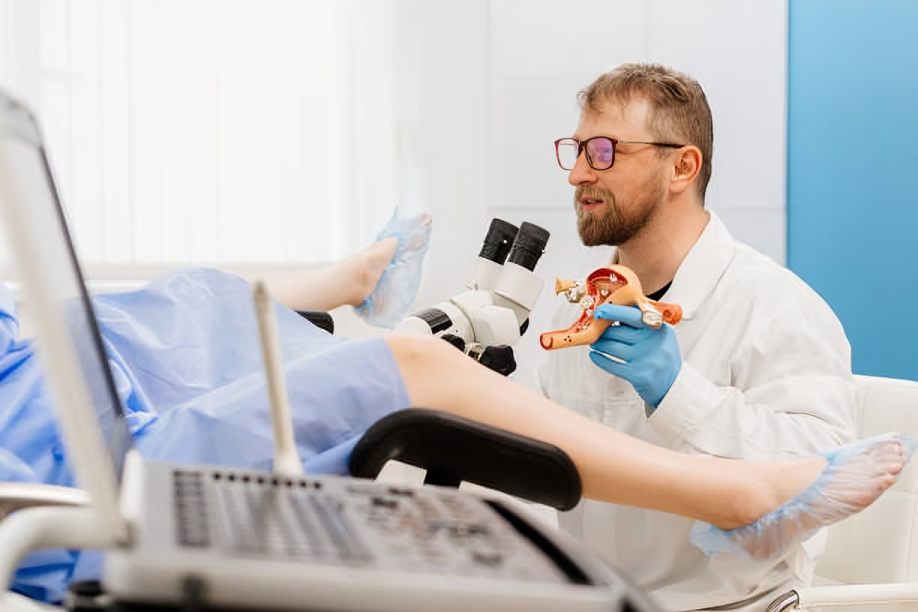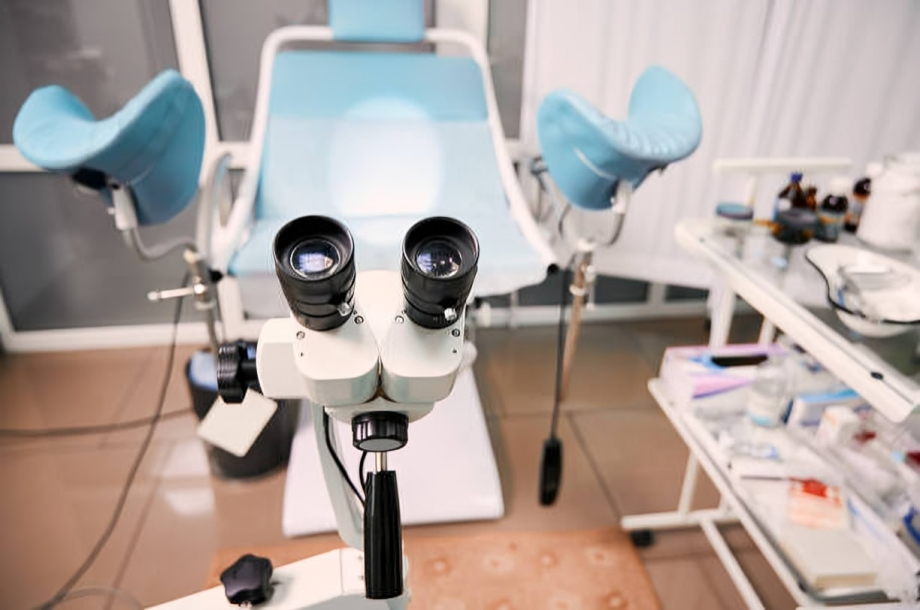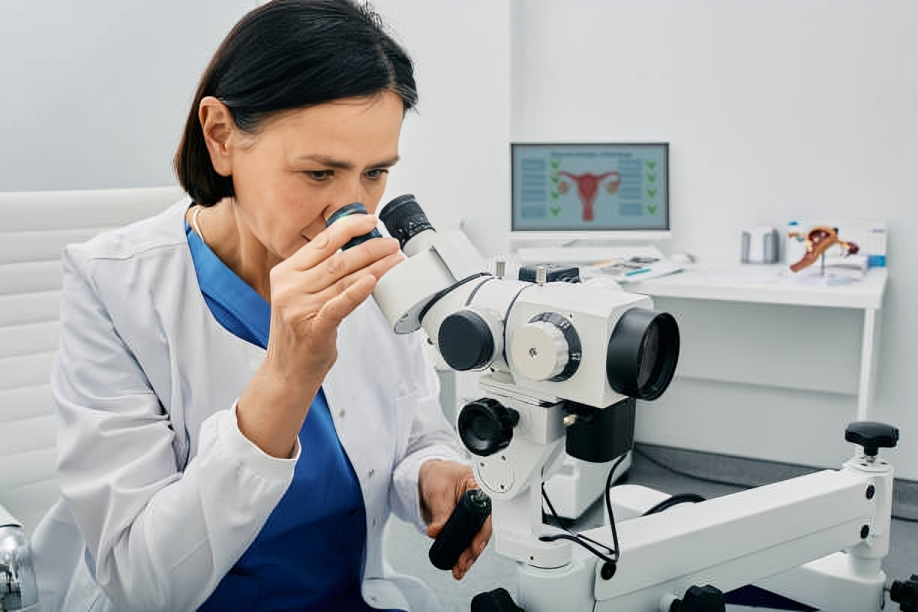Colposcopy is a non-invasive diagnostic procedure to visualize the surface of the lower part of your reproductive tract, including the cervix, vagina, and vulva.
What is Colposcopy?
Colposcopy is a diagnostic procedure that uses a colposcope, a specialized microscope with magnification lenses, to provide a well-lit, enlarged view of the cervix, vagina, and vulva. The primary aim of this procedure is to detect precancerous and cancerous lesions early, allowing for timely and effective treatment. It can be performed by a skilled doctor or healthcare provider only with colposcopy training. They use a colposcope, a light microscope, to inspect the walls of your organs for any abnormalities.
In the United States, it is usually not performed under anesthesia. You are awake and fully aware during colposcopy.1Cooper, D. B., & Dunton, C. J. (2023, November 12). Colposcopy. Nih.gov; StatPearls Publishing. https://www.ncbi.nlm.nih.gov/books/NBK564514/
Indications of Colposcopy
The anatomy of the lower genital organs is complex, so it is hard to examine different structures. Whether the patient has benign conditions like warts or screening for malignancy, a colposcopy can help doctors visualize your genitalia better.
This procedure also plays an essential role in the early detection of precancerous lesions in the cervix and the follow-up of patients undergoing treatment.2Prendiville, W., & Rengaswamy Sankaranarayanan. (2017). The role of colposcopy in cervical precancer. Nih.gov; International Agency for Research on Cancer. https://www.ncbi.nlm.nih.gov/books/NBK568372/
Abnormal Test Results
If you have abnormal pap smear test results or test positive for HPV, your doctor will recommend you undergo this procedure. HPV, or the human papillomavirus, is associated with a variety of cancers, especially cervical cancer.
Cervical cancer advances silently, so it is important to rule it out before the disease has progressed too far. Therefore, doctors observe your cervix, vulva, and vagina under a light source to make sure there are no signs of malignancy.
Unexplained Bleeding & Discharge
Colposcopy is used for assessment of bleeding after sex, as it could be a sign of cancer or infection. Your doctor may recommend it if you have an abnormal vaginal discharge.
Benign Abnormalities
Colposcopy can detect benign abnormalities in your reproductive system and differentiate between them and precancerous changes. These conditions include:
- Infections
- Ectropion
- Erosion
- Cervical myomas
- Polyps
- Warts
- Fallopian tube disorders
- Endometriosis
DES Exposure
Diethylstilbestrol, or DES, was a drug prescribed to prevent miscarriages until the 1960s. Research has found higher rates of cervical and vaginal cancer in the daughters of the women who took DES. If your mother was prescribed DES, your doctor will recommend you undergo routine colposcopy procedures to make sure you stay healthy and safe.3Tournaire, M., Devouche, E., Lafaye, N., & Levadou, A. (2021). Screening for cancers of the cervix and vagina for women exposed to diethylstilbestrol (DES) in utero. Journal of Gynecology Obstetrics and Human Reproduction, 50(7), 102042–102042. https://doi.org/10.1016/j.jogoh.2020.102042
As a Follow-Up Procedure
Colposcopy is often used as the follow-up procedure for cancer patients. It also helps monitor hormone-induced changes in your lower reproductive tract due to medical treatment or removal of your ovaries and uterus (hysterectomy).
If you have any past medical history of fast-spreading cancer, your doctor can perform this procedure to make sure it doesn’t come back and affect the organs where the disease spreads without symptoms.

What can I do for Colposcopy Preparation?
This procedure is performed at hospitals and women’s health centers. Before the procedure, your healthcare provider will examine and counsel you on how to prepare for colposcopy.
History & Examination
Your doctor will conduct a gynecological history and physical exam to note any complaints you’ve been having. Your signs and symptoms will also help them avoid unnecessary tests. They will ask you questions such as:
- Is your menstrual cycle regular?
- Have you started menopause? Have you noticed any abnormal bleeding afterward?
- Do you bleed in between your periods?
- Have you experienced any bleeding or pain after sex?
- Have you noticed any changes in the color, smell, or texture of your vaginal discharge?
- Do you experience any itching or pain “down there”?
They will also ask you questions about your medical history and family history, such as any previous pap smear results and history of sexually transmitted infections. The doctors will ask if you or anyone in your family has had cancer. They can also ask if your mother ever took any pills to help her pregnancy before she had you.
Informed Consent
Informed consent means your doctor told you about all the steps, risks, and future outcomes of the treatment you seek before they asked you to undergo it. Your doctor will explain all the details about the colposcopy procedure to you and get your signature on a document as proof of your consent. The form often includes details about the purpose of colposcopy and basic steps—potential risks, downtime, and complications.
What to avoid before Colposcopy?
Several activities should be avoided before your colposcopy appointment. You should avoid any activity that could strain and tire your core muscles. Similarly, you should avoid placing anything in your vagina so that the appearance of your cervical walls doesn’t change, such as tampons, vaginal deodorants, vaginal suppositories, vaginal douching, or penetrative sex.
You should also discuss the medication you are currently taking with your doctor. Some drugs (like aspirin) can increase the amount of bleeding after this procedure.
Step-by-step Procedure for Colposcopy
Preparing for Colposcopy Appointment
On the day of your procedure appointment, you will be asked to go to your hospital or health clinic’s women’s health or colposcopy unit. A healthcare professional will give you a sterile hospital gown to wear.
Position during Colposcopy
Your doctor will help you get into a modified lithotomy position. They will ask you to lie on your back and flex your hips and knees. They will then support your legs on stirrups and slightly tilt the exam table. The lithotomy position is also used in other gynecologic procedures, allowing clear visualization of the female anatomy.
Colposcopy Anesthesia
Doctors usually don’t perform these procedures under anesthesia. The cervix lacks pain receptors and has a thick wall, which causes less pain. The discomfort you would feel during the administration of local anesthesia through a syringe could be more than that of the procedure itself. If required, local anesthesia usually includes lignocaine and bupivacaine.
According to guidelines, only twenty percent of colposcopies should be performed under general anesthesia.4Swancutt, DM Luesley, JL Eastaugh, & Wilson, S. (2008). Anesthetic choice in the colposcopy clinic: a retrospective analysis of routinely collected data. BJOG, 115(5), 646–652. https://doi.org/10.1111/j.1471-0528.2008.01664.x

Colposcopy Procedure
- The doctor’s assistant will place the colposcope in an ideal position between your legs.
- After exposing the lower half of your body, the doctor will insert a self-retaining speculum into your vagina.
- The doctor will first inspect your external genitalia using the colposcope.
- Then, they will examine all four walls of your cervix for signs of inflammation or precancer and check your blood vessels.
- They will examine your cervix after applying acetic acid to your cervix. Acetic acid makes abnormalities appear white.
- Your doctor might also examine your endocervix with an endocervical speculum.
- After this, they will apply an iodine solution, making precancerous lesions yellow.
- They will decide whether to do a biopsy if they find any abnormality.
- Finally, they will document the findings at the end of the procedure.
Possible Results of Colposcopy
If you had a standard colposcopy, your doctor may tell you about your results right after they have documented the procedure’s findings. However, if you had a biopsy alongside colposcopy, you may have to wait up to 8 weeks.
What if Colposcopy is Negative?
Negative colposcopy means no abnormalities were found on the lining of your cervix, vagina, and vulva. However, depending on your history and exam, the doctor might perform a biopsy or ask you for a follow-up in a few months.
What if Colposcopy is Positive?
When the result of this procedure is positive, it means the doctor found some abnormality during your exam:
- Unusual spots and bumps on the cervix
- More blood vessels
- Abnormal tissue patterns
- Abnormal color and textures
- Discolored patches

After discovering the positive results, the doctors will conduct tests to determine your lesion grade.
What happens if a Colposcopy is Abnormal?
Doctors conduct curettage or biopsy to determine the grade of precancerous lesions present in your cervix. They will observe low-grade lesions and opt for medical and surgical treatment for high-grade lesions. The doctors advise radiotherapy, chemotherapy, and surgery for the management of cancer.
Can a Colposcopy have different results from a Pap Smear?
Yes! Sometimes, a colposcopy shows everything is normal, even when abnormal pap smear results are present. This can happen because the pap smear detected subclinical changes in your cells. Subclinical changes are those that are not visible on examination. In addition, the lesions might only be confined to the deeper layers of your tissue and could be invisible on colposcopy.5Updated Guidelines for Management of Cervical Cancer Screening Abnormalities. (2020). Acog.org. https://www.acog.org/clinical/clinical-guidance/practice-advisory/articles/2020/10/updated-guidelines-for-management-of-cervical-cancer-screening-abnormalities
Follow-up after a Colposcopy
The follow-up after the procedure depends on the procedure’s findings. Usually, women have to follow up every six months so that their doctors can observe the abnormal cell changes for any growth. This continues until the patient has had at least two negative screening test results. In case of abnormal findings, you may need to visit your doctor more frequently.
Contraindications of the Colposcopy Procedure
This is generally a safe procedure. Sometimes, it can cause complications in pregnancy. It may also cause an ascending spread of infections. It is better to avoid it when the view of the colposcope could get obscured. Contraindications include:
- Pregnancy (Not with biopsies)
- Vaginal atrophy
- Severe vaginitis
- Severe cervicitis
- Active infection in the female reproductive tract
- Vaginal scarring
- Vaginal stenosis
- Heavy bleeding (e.g., menstruation, postpartum)6Ranu Patni. (2022). Colposcopy postmenopause: A challenge in cervical cancer elimination goal! Journal of Mid-Life Health, 13(3), 263–263. https://doi.org/10.4103/jmh.jmh_138_22
Side Effects of Colposcopy
Colposcopy itself does not have side effects beyond some pain and discomfort. It does not affect fertility. Complications result from improper technique and poor infection control. You may experience:
- Soreness and pain
- Discomfort
- Bleeding or dark discharge
- Infection (if the sterile field is broken)
- Trauma to genital track (if improper technique is used)
How long does it take for your Cervix to heal after a colposcopy?
Your cervix heals itself in a few days after colposcopy. Your bleeding stops within a few days, though some women may notice spotting for a month. You can resume your daily activities within a week. However, a small percentage of women say colposcopy affected their sex life months after the procedure due to complications.7Flanagan, S. M., Wilson, S., Luesley, D., Damery, S. L., & Greenfield, S. M. (2011). Adverse outcomes after colposcopy. BMC Women’s Health, 11(1). https://doi.org/10.1186/1472-6874-11-2
What should I avoid after the Colposcopy Procedure?
You should get a ride home instead of walking. Avoid strenuous exercise and activities that can tire your pelvic muscles.
Avoid putting any objects into your vagina for a few days after colposcopy. You should wait 3-4 days before having sex, too. Use pads or napkins instead of menstrual cups and napkins if you start your period soon after colposcopy.
Is it OK to take a bath after a Colposcopy?
You should avoid baths and swimming pools after a colposcopy. The chemicals in bath bombs, as well as extreme temperatures in water, can cause trauma to your sensitive genital tract. The chlorine in swimming pools could irritate your tissues while they heal. The microorganisms present in water could cause infection.
When should you see a doctor after a Colposcopy?
Depending on your results, you would typically only need to see a doctor for a follow-up after six months. However, you should seek immediate medical attention if you notice any signs of infection (abnormal discharge, fever, pain) or heavy bleeding.
LEEP Vs. Colposcopy
LEEP stands for “Loop Electrosurgical Excision Procedure.” It is a medical procedure that removes abnormal cells from your cervix using a wire loop heated by an electric current. It prevents cancer by removing precancerous lesions.
On the other hand, colposcopy is a diagnostic procedure that involves visualizing the surface lining of your cervix, vagina, and vulva. It prevents cancer by detecting precancerous lesions.
Difference Between Colposcopy And Cervical Biopsy
Colposcopy is a visual examination procedure used to check the cervix, vulva, and vagina for any superficial abnormalities. It may or may not be accompanied by a cervical biopsy, which is the sampling of cells and tissues of the cervix to analyze for abnormalities.
Is Colposcopy more accurate than Smear?
Research has shown that colposcopy is more accurate than smear in detecting precancerous lesions of the cervix. It is also more precise in the detection of cervical cancer. However, the pap smear is more cost-effective as a screening tool. 8Mojgan Karimi-Zarchi, Zanbagh, L., Alireza Shafii, Shokouh Taghipour-Zahir, Teimoori, S., & Pouria Yazdian-Anari. (2015). Comparison of Pap Smear and Colposcopy in Screening for Cervical Cancer in Patients with Secondary Immunodeficiency. Electronic Physician, 7(7), 1542–1548. https://doi.org/10.19082/1542
Conclusion
Colposcopy is a procedure used to visualize the surfaces of the female genital tract. It helps screen for cervical cancer. Other than cancer, it can also diagnose benign conditions and infections. It is a daycare procedure performed without anesthesia. It does not have any long-term side effects.
Refrences
- 1Cooper, D. B., & Dunton, C. J. (2023, November 12). Colposcopy. Nih.gov; StatPearls Publishing. https://www.ncbi.nlm.nih.gov/books/NBK564514/
- 2Prendiville, W., & Rengaswamy Sankaranarayanan. (2017). The role of colposcopy in cervical precancer. Nih.gov; International Agency for Research on Cancer. https://www.ncbi.nlm.nih.gov/books/NBK568372/
- 3Tournaire, M., Devouche, E., Lafaye, N., & Levadou, A. (2021). Screening for cancers of the cervix and vagina for women exposed to diethylstilbestrol (DES) in utero. Journal of Gynecology Obstetrics and Human Reproduction, 50(7), 102042–102042. https://doi.org/10.1016/j.jogoh.2020.102042
- 4Swancutt, DM Luesley, JL Eastaugh, & Wilson, S. (2008). Anesthetic choice in the colposcopy clinic: a retrospective analysis of routinely collected data. BJOG, 115(5), 646–652. https://doi.org/10.1111/j.1471-0528.2008.01664.x
- 5Updated Guidelines for Management of Cervical Cancer Screening Abnormalities. (2020). Acog.org. https://www.acog.org/clinical/clinical-guidance/practice-advisory/articles/2020/10/updated-guidelines-for-management-of-cervical-cancer-screening-abnormalities
- 6Ranu Patni. (2022). Colposcopy postmenopause: A challenge in cervical cancer elimination goal! Journal of Mid-Life Health, 13(3), 263–263. https://doi.org/10.4103/jmh.jmh_138_22
- 7Flanagan, S. M., Wilson, S., Luesley, D., Damery, S. L., & Greenfield, S. M. (2011). Adverse outcomes after colposcopy. BMC Women’s Health, 11(1). https://doi.org/10.1186/1472-6874-11-2
- 8Mojgan Karimi-Zarchi, Zanbagh, L., Alireza Shafii, Shokouh Taghipour-Zahir, Teimoori, S., & Pouria Yazdian-Anari. (2015). Comparison of Pap Smear and Colposcopy in Screening for Cervical Cancer in Patients with Secondary Immunodeficiency. Electronic Physician, 7(7), 1542–1548. https://doi.org/10.19082/1542

